HTML
--> --> -->The samples were radiated at the K-400 Neutron Generator at China Academy of Engineering Physics (CAEP) and lasted for 6.5-10 h. Neutrons in the 14 MeV region with a yield ranging from 4×1010 n/s to 5×1010 n/s were generated from the T(d,n)4He reaction under a deuteron beam energy of 255 keV and a beam current of 350 μA. The solid tritium–titanium (T-Ti) target applied to the generator was approximately 2.19 mg/cm2 thick. In the process of the radiation of the samples, the neutron flux was detected by an Au-Si surface barrier detector used in 135° accompanying a particle tube to correct small variations of neutron flux. The samples were put at 0°-135° angles relative to the direction of the deuteron beam and with distances from the center of the T-Ti target of approximately 40-50 mm. The neutron energies in the measurements were determined in advance from the cross section ratios of 90Zr(n,2n)89m+gZr to93Nb(n,2n)92mNb reactions [20].
The γ-ray activities of 184mRe, 184gRe, 182m1+m2+gTa, 186gRe, 184Ta, 187W, and 92mNb were determined by a well-calibrated GEM-60P coaxial high-purity germanium ORTEC detector made in USA (its crystal diameter is 70.1 mm and crystal length is 72.3 mm) with a relative efficiency of 68% and an energy resolution of 1.69 keV at 1332 keV. The efficiency of the detector was pre-calibrated using various standard γ sources. Activities of decay γ-rays from the product radionuclides were recorded 90 mm away from the detector’s surface. The cooling time of the irradiated sample was approximately 18 min-136.32 h, and the measuring time was approximately 23 min-20.78 h. Figures 1 and 2 show part of the γ-ray spectrum obtained from the rhenium samples at approximately 6.78 and 125.45 h after the end of irradiation, respectively.
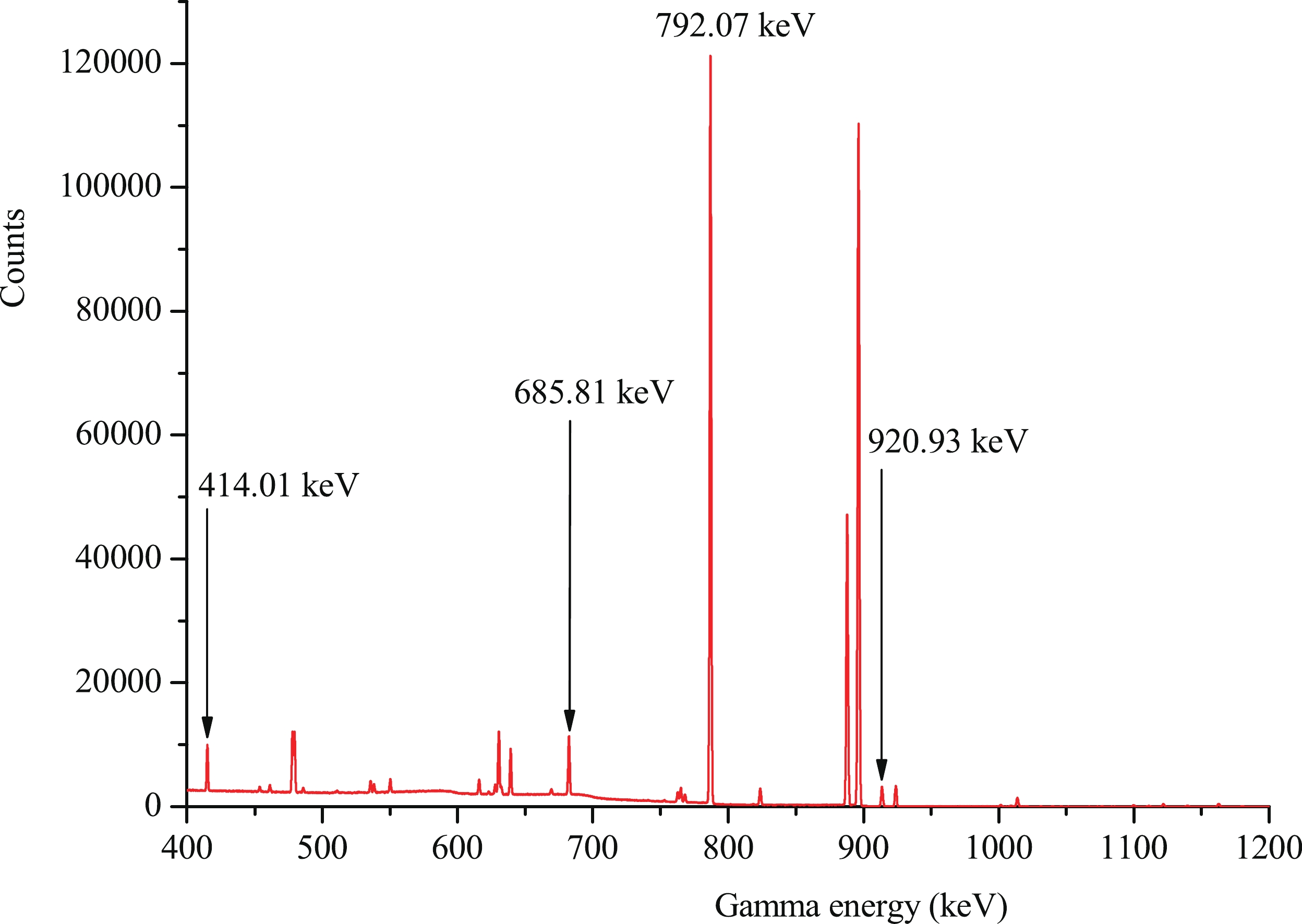 Figure1. (color online) Part of the γ-ray spectrum of rhenium obtained after 6.78 h of cooling following the end of irradiation; the measurement duration was approximately 3.82 h.
Figure1. (color online) Part of the γ-ray spectrum of rhenium obtained after 6.78 h of cooling following the end of irradiation; the measurement duration was approximately 3.82 h.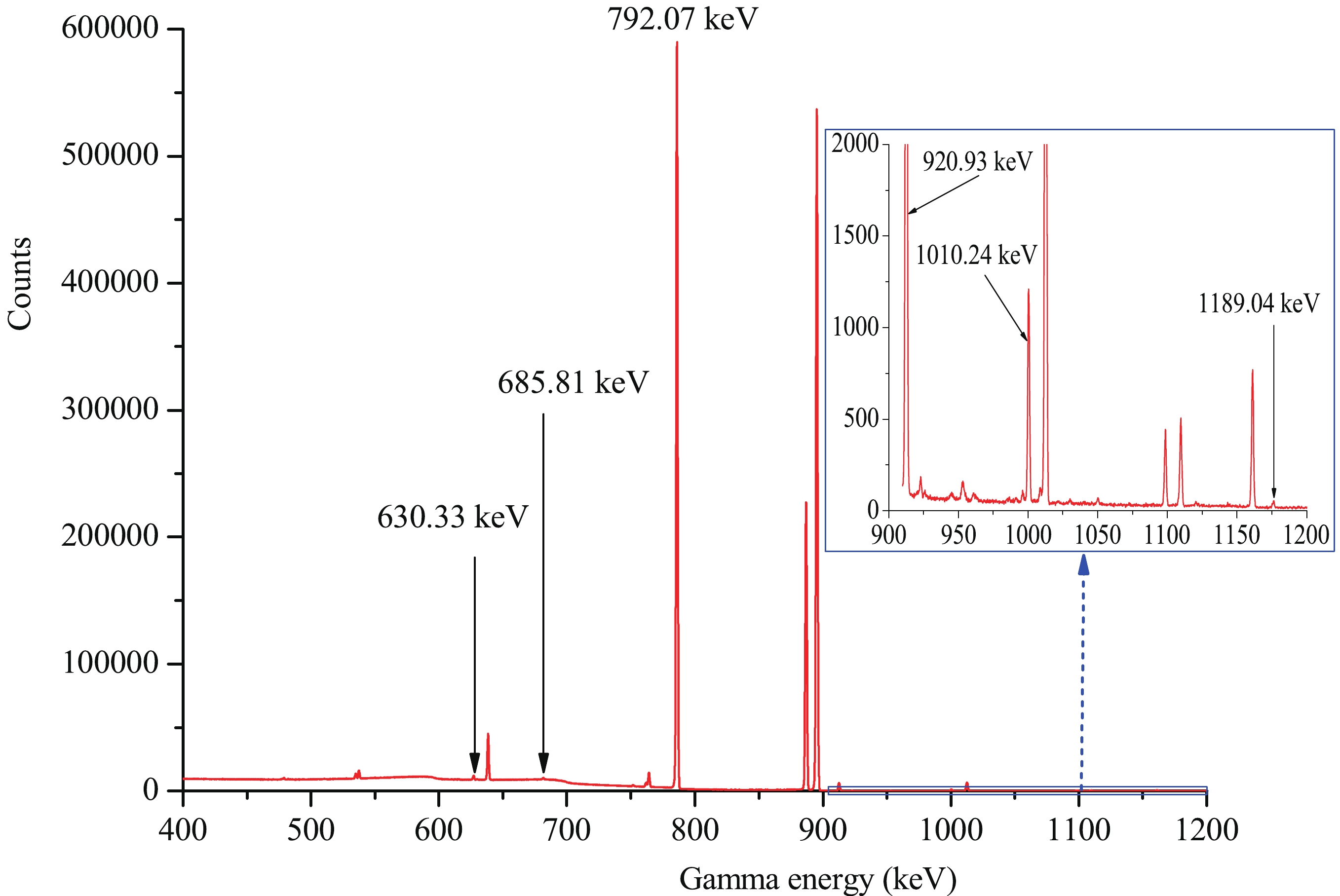 Figure2. (color online) Part of the γ-ray spectrum of rhenium obtained after 125.45 h of cooling following the end of irradiation; the measurement duration was approximately 20.78 h.
Figure2. (color online) Part of the γ-ray spectrum of rhenium obtained after 125.45 h of cooling following the end of irradiation; the measurement duration was approximately 20.78 h.| Reaction | Abundance of target isotope (%) | Activation products | T1/2 | Eγ/keV | Iγ(%) |
| 185Re(n,2n) | 37.40 | 184mRe | 169 d | 920.93 | 8.2 |
| 185Re(n,2n) | 37.40 | 184gRe | 35.4 d | 792.07 | 37.7 |
| 1010.24 | 0.092 | ||||
| 185Re(n,α) | 37.40 | 182m1+m2+gTa | 114.74 d | 1189.04 | 16.49 |
| 187Re(n,2n) | 62.60 | 186gRe | 3.7183 d | 630.33 | 0.0294 |
| 187Re(n,α) | 62.60 | 184Ta | 8.7 h | 414.01 | 72 |
| 187Re (n,p) | 62.60 | 187W | 24.0 h | 685.81 | 33.2 |
| 93Nb(n,2n) | 100 | 92mNb | 10.15 d | 934.44 | 99.15 |
Table1.Reactions and associated decay data of activation products.
The measured cross-section values were calculated by the following formula [23, 24]:
${\sigma _x} = \frac{{{{[S\varepsilon {I_\gamma }\eta KMD]}_0}}}{{{{[S\varepsilon {I_\gamma }\eta KMD]}_x}}}\frac{{{{[\lambda AFC]}_x}}}{{{{[\lambda AFC]}_0}}}{\sigma _0}.$ | (1) |
$F = {F_s} \times {F_c} \times {F_g},$ | (2) |
${F_s} = \frac{{{\mu _{{m}}}{d_m}}}{{1 - {{\rm e}^{ - {\mu _m}{d_m}}}}},$ | (3) |
${F_g} = \frac{{{{(h + d/2)}^2}}}{{{h^2}}},$ | (4) |
K is the neutron fluctuation factor:
$K = \left[ {\sum\limits_i^L {{\Phi _i}} \left( {1 - {{\rm e}^{ - \lambda \Delta {t_i}}}} \right){{\rm e}^{ - \lambda {T_i}}}} \right] \Big/\Phi S,$  | (5) |
Cross sections of the 185Re(n,2n)184mRe, 185Re(n,2n) 184gRe, 185Re(n,α)182m1+m2+gTa, 187Re(n,2n)186g,(m)Re, 187Re(n,α)184Ta, and 187Re(n,p)187W reactions were obtained. The cross-section data of the monitor reaction 93Nb(n,2n)92mNb were 457.9± 6.8, 459.8 ± 6.8, 459.8 ± 6.8, and 459.7 ± 5.0 mb at neutron energies of 13.5, 14.1, 14.4, and 14.8 MeV, respectively [26]. The measured cross-section data are presented in Table 2 and charted in Figs. 3-8. Previously obtained experimental cross sections of these nuclear reactions around the neutron energy of 14 MeV are also summarized in Table 2 and charted in Figs. 3-8 for comparison. Likewise, the evaluation cross-section curves of these reactions from BROND-3.1, ENDF/B-VIII.0, JEFF-3.3, and the theoretical calculation curves in the neutron energy range from the threshold to 20 MeV obtained by the computer code system Talys-1.9 are also charted in Figs. 3-8 for comparison.
| Reaction | This study | Literature Values | ||||
| En/MeV | σ/mb | En/MeV | σ/mb | Reference | ||
| 185Re(n,2n)184mRe | 13.5±0.2 | 397±29 | 14.7 | 390±18 | [2] | |
| 14.1±0.2 | 409±30 | 14.74 | 357±33 | [4] | ||
| 14.4±0.2 | 414±30 | 13.4 | 403±16 | [5] | ||
| 14.8±0.2 | 415±30 | 13.7 | 400±16 | [5] | ||
| 14.1 | 395±16 | [5] | ||||
| 14.45 | 389±16 | [5] | ||||
| 14.65 | 392±16 | [5] | ||||
| 14.8 | 399±16 | [5] | ||||
| 14.3 | 380±50 | [6] | ||||
| 14.7 | 390±70 | [6] | ||||
| 14.44 | 442±21 | [7] | ||||
| 14.47 | 428±21 | [7] | ||||
| 13.33 | 312±26 | [8] | ||||
| 13.57 | 325±26 | [8] | ||||
| 13.75 | 332±27 | [8] | ||||
| 13.98 | 321±26 | [8] | ||||
| 14.22 | 341±28 | [8] | ||||
| 14.43 | 335±28 | [8] | ||||
| 14.67 | 359±30 | [8] | ||||
| 14.93 | 347±29 | [8] | ||||
| 13.54 | 322±48 | [9] | ||||
| 13.73 | 345±52 | [9] | ||||
| 14.67 | 301±45 | [9] | ||||
| 14.81 | 416±62 | [9] | ||||
| 14.8 | 260±100 | [10] | ||||
| 14.1 | 1120±400 | [11] | ||||
| 185Re(n,2n)184gRe | 13.5±0.2 | 1800±82a (1753±155b) | 14.7 | 1817±85 | [2] | |
| 14.1±0.2 | 1787±83a (1727±154b) | 14.74 | 1488±88 | [4] | ||
| 14.4±0.2 | 1752±79a (1724±152b) | 13.4 | 1850±74 | [5] | ||
| 14.8±0.2 | 1699±77a (1677±149b) | 13.7 | 1844±74 | [5 | ||
| 14.1 | 1838±74 | [5] | ||||
| 14.45 | 1832±73 | [5] | ||||
| 14.65 | 1778±71 | [5] | ||||
| 14.8 | 1776±71 | [5] | ||||
| 14.3 | 1670±95 | [6] | ||||
| 14.7 | 1780±120 | [6] | ||||
| 14.44 | 1886±75 | [7] | ||||
| 14.47 | 1886±71 | [7] | ||||
| 13.33 | 1399±73 | [8] | ||||
| 13.56 | 1436±75 | [8] | ||||
| Continued on next page | ||||||
Table2.Summary of the cross sections of Rhenium isotopes around the neutron energy of 14 MeV.
| Table 2-continued from previous page | ||||||
| Reaction | This work | Literature Values | ||||
| En/MeV | σ/mb | En/MeV | σ/mb | Reference | ||
| 13.75 | 1416±74 | [8] | ||||
| 13.98 | 1389±72 | [8] | ||||
| 14.22 | 1414±73 | [8] | ||||
| 14.43 | 1370±72 | [8] | ||||
| 14.66 | 1385±72 | [8] | ||||
| 14.93 | 1420±74 | [8] | ||||
| 14.1 | 1910±600 | [11] | ||||
| 14.7 | 1900±100 | [12] | ||||
| 15.3 | 2170±100 | [12] | ||||
| 16.1 | 1670±90 | [12] | ||||
| 16.8 | 1260±70 | [12] | ||||
| 17.3 | 1240±60 | [12] | ||||
| 18.3 | 900±50 | [12] | ||||
| 185Re(n,α)182m1+m2 +gTa | 13.5±0.2 | 0.56±0.05 | 14.48 | 1.40±0.50 | [4] | |
| 14.1±0.2 | 0.61±0.06 | 14.7 | 1.4±0.2 | [13] | ||
| 14.4±0.2 | 0.65±0.07 | |||||
| 14.8±0.2 | 0.75±0.06 | |||||
| 187Re(n,2n)186g,(m)Re | 13.5±0.2 | 1734±75 | 14.85 | 1680±99 | [4] | |
| 14.1±0.2 | 1661±75 | 14.8 | 1490±160 | [10] | ||
| 14.4±0.2 | 1614±71 | 14.1 | 1440±410 | [11] | ||
| 14.8±0.2 | 1560±68 | 14.7 | 1140±60 | [12] | ||
| 15.3 | 1390±70 | [12] | ||||
| 16.1 | 950±50 | [12] | ||||
| 16.8 | 690±40 | [12] | ||||
| 17.3 | 820±40 | [12] | ||||
| 18.3 | 710±40 | [12] | ||||
| 13.5 | 1857±90 | [13] | ||||
| 14.2 | 1863±90 | [13] | ||||
| 14.7 | 1881±93 | [13] | ||||
| 14.1 | 1966.9±50.3 | [14] | ||||
| 14.6 | 1967.1±44.7 | [14] | ||||
| 14.8 | 1952.0±50.7 | [14] | ||||
| 15.0 | 1903.0±50.3 | [14] | ||||
| 14.8 | 1675±168 | [15] | ||||
| 187Re(n,α)184Ta | 13.5±0.2 | 0.34±0.02 | 13.67 | 0.316±0.05 | [4] | |
| 14.1±0.2 | 0.42±0.02 | 14.06 | 0.416±0.05 | [4] | ||
| 14.4±0.2 | 0.54±0.03 | 14.46 | 0.561±0.05 | [4] | ||
| 14.8±0.2 | 0.63±0.03 | 14.84 | 0.609±0.05 | [4] | ||
| 14.47 | 0.445±0.064 | [8] | ||||
| 14.70 | 0.558±0.097 | [8] | ||||
| Continued on next page | ||||||
| Table 2-continued from previous page | ||||||
| Reaction | This work | Literature Values | ||||
| En/MeV | σ/mb | En/MeV | σ/mb | Reference | ||
| 14.96 | 0.63±0.11 | [8] | ||||
| 14.8 | 0.53±0.03 | [12] | ||||
| 15.3 | 0.89±0.05 | [12] | ||||
| 16.1 | 1.07±0.06 | [12] | ||||
| 16.8 | 1.06±0.06 | [12] | ||||
| 17.3 | 0.99±0.05 | [12] | ||||
| 18.3 | 1.52±0.08 | [12] | ||||
| 14.7 | 1.1±0.1 | [13] | ||||
| 14.5 | 0.94±0.14 | [16] | ||||
| 187Re(n,p)187W | 13.5±0.2 | 2.05±0.09 | 13.67 | 2.75±0.30 | [4] | |
| 14.1±0.2 | 2.50±0.11 | 14.06 | 3.18±0.30 | [4] | ||
| 14.4±0.2 | 2.98±0.13 | 14.46 | 3.45±0.35 | [4] | ||
| 14.8±0.2 | 3.27±0.14 | 14.84 | 3.94±0.29 | [4] | ||
| 13.34 | 4.51±0.51 | [8] | ||||
| 13.57 | 4.00±0.71 | [8] | ||||
| 13.76 | 4.40±0.76 | [8] | ||||
| 13.99 | 5.10±0.71 | [8] | ||||
| 14.23 | 4.88±0.79 | [8] | ||||
| 14.44 | 5.33±0.41 | [8] | ||||
| 14.68 | 5.59±0.65 | [8] | ||||
| 14.95 | 6.60±0.75 | [8] | ||||
| 13.5 | 3±0.3 | [13] | ||||
| 14.2 | 4±0.4 | [13] | ||||
| 14.7 | 4.5±0.5 | [13] | ||||
| 14.5 | 3.93±0.39 | [16] | ||||
| 14.7 | 4.7±0.4 | [17] | ||||
| aThese are the results based on the 792.07 keV γ-ray of 184gRe. bThese are the results based on the 1010.24 keV γ-ray of 184gRe. | ||||||
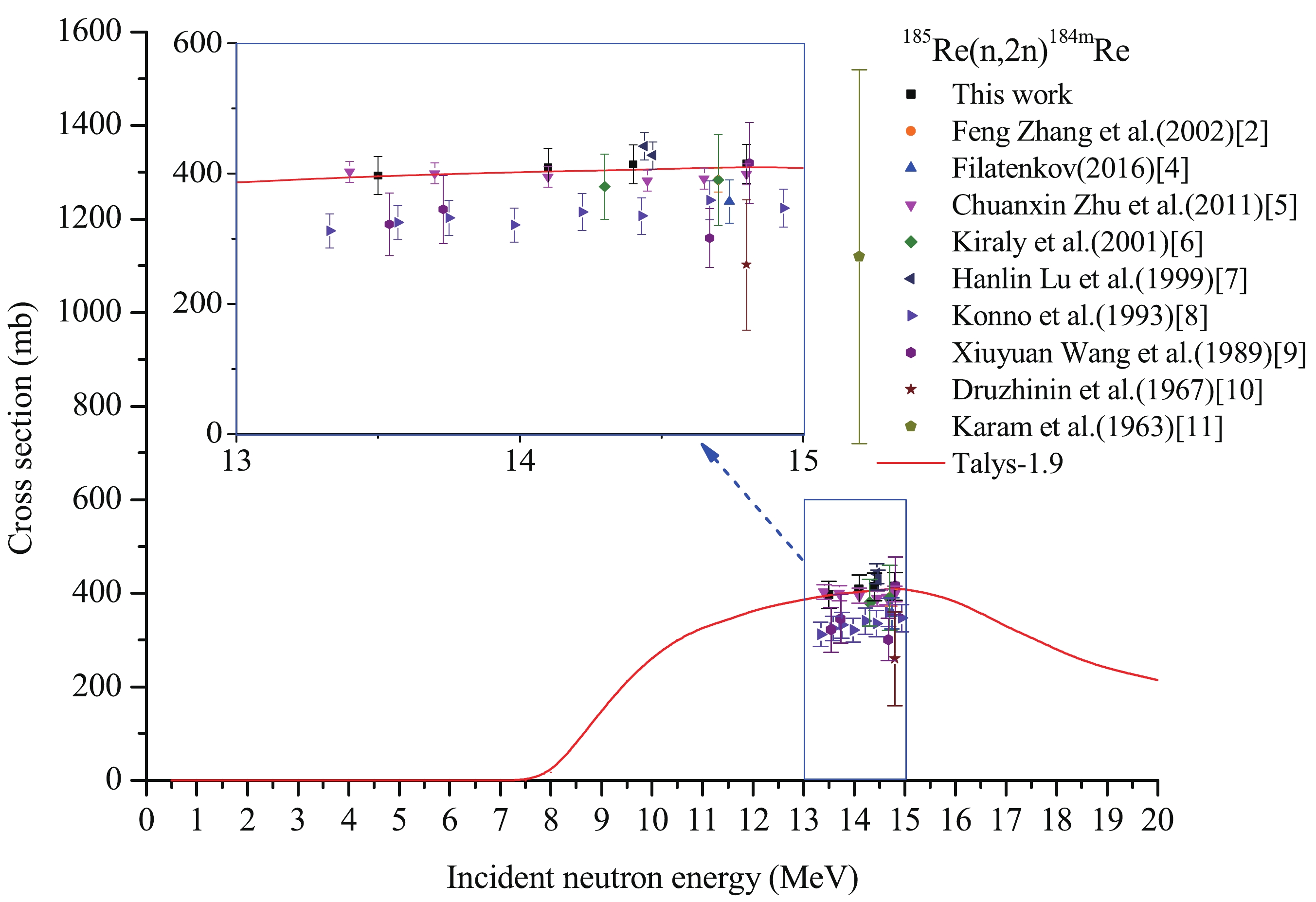 Figure3. (color online) Cross section of the 185Re(n,2n)184mRe reaction.
Figure3. (color online) Cross section of the 185Re(n,2n)184mRe reaction. Figure4. (color online) Cross section of the 185Re(n,2n)184gRe reaction.
Figure4. (color online) Cross section of the 185Re(n,2n)184gRe reaction.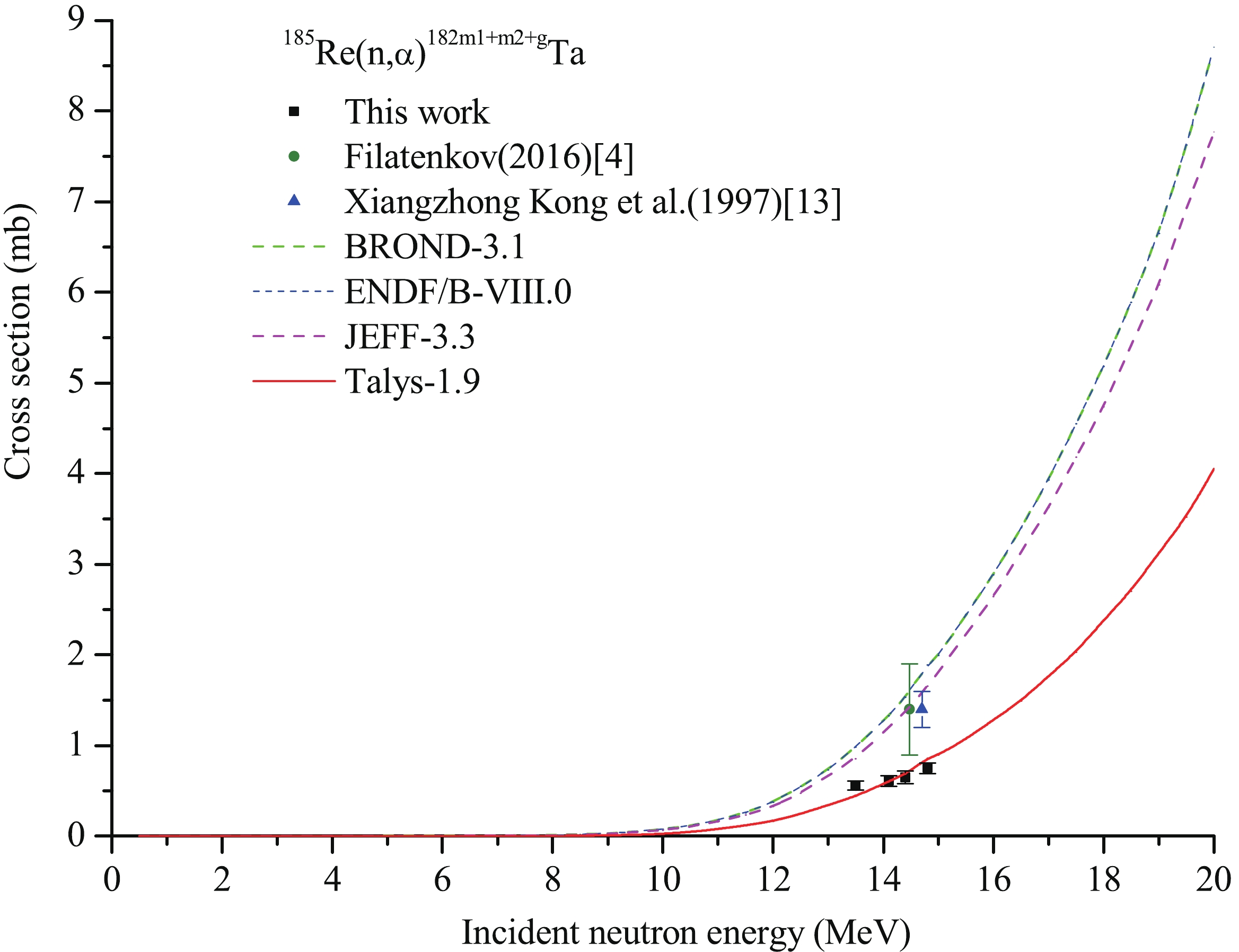 Figure5. (color online) Cross section of the 185Re(n,α)182m1+m2+gTa reaction.
Figure5. (color online) Cross section of the 185Re(n,α)182m1+m2+gTa reaction. Figure6. (color online) Cross section of the 187Re(n,2n)186g,(m)Re reaction.
Figure6. (color online) Cross section of the 187Re(n,2n)186g,(m)Re reaction.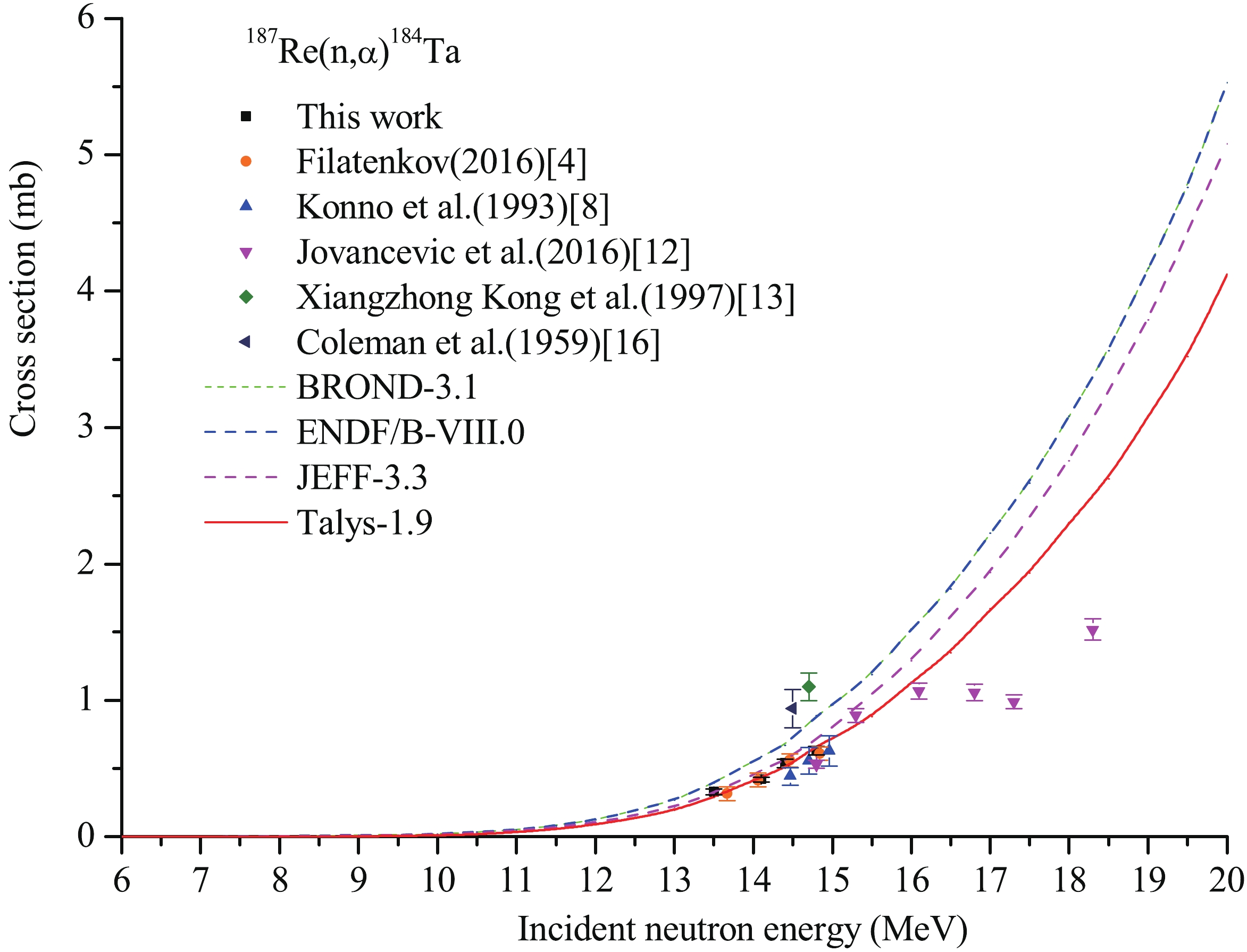 Figure7. (color online) Cross section of the 187Re(n,α)184Ta reaction.
Figure7. (color online) Cross section of the 187Re(n,α)184Ta reaction.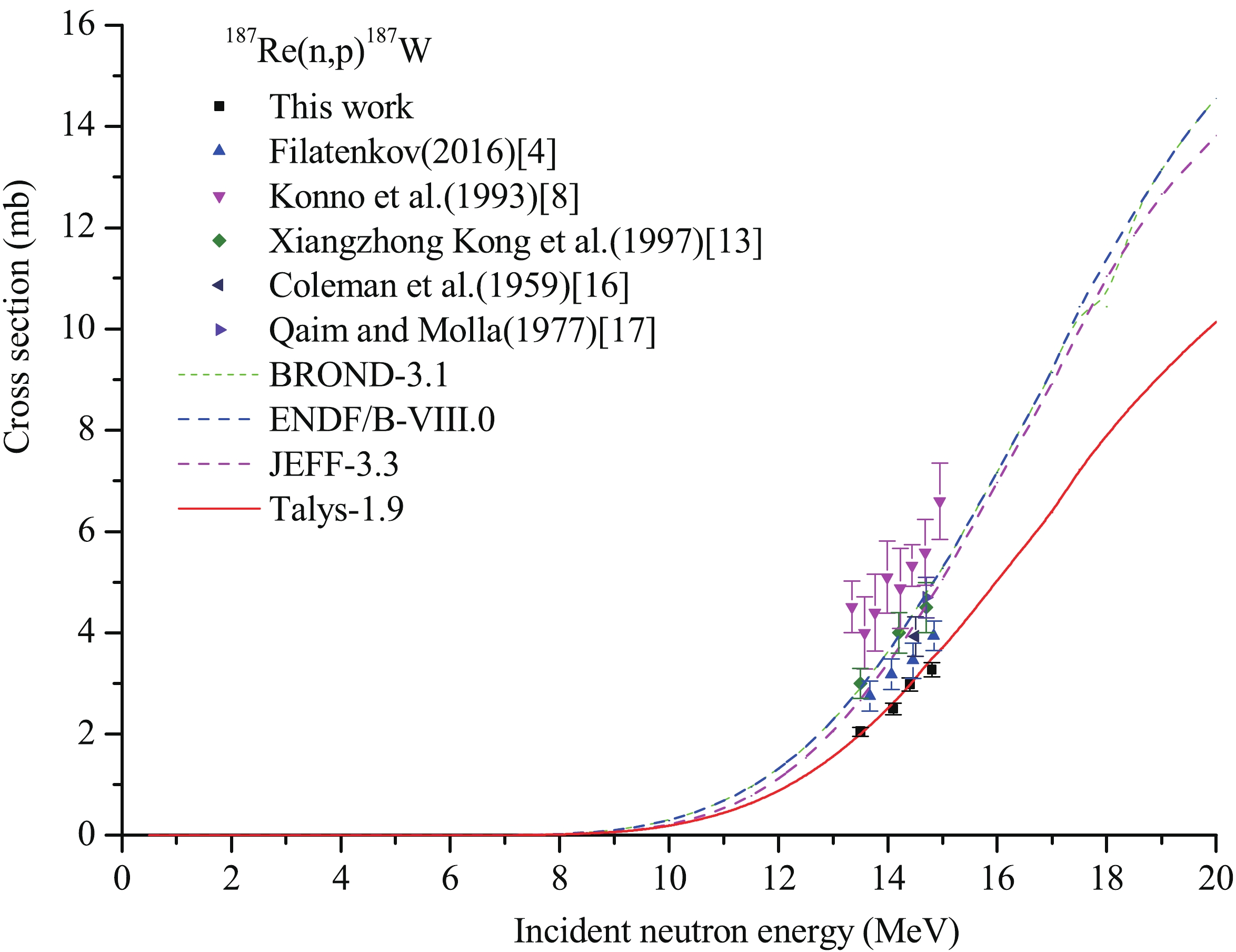 Figure8. (color online) Cross section of the 187Re(n,p)187W reaction.
Figure8. (color online) Cross section of the 187Re(n,p)187W reaction.To obtain accurate cross-section values of the 185Re(n,2n)184gRe reaction, the effect of the decay of the excited state 184mRe on the ground state 184gRe and the contribution of the 792.07 keV γ-ray (intensity 3.69%) of 184mRe on the 792.07 keV γ-ray (intensity 37.7%) of 184gRe must be deducted. However, the former was not mentioned in Refs. [2, 7] and the latter was not mentioned in Refs. [4, 5]. Our experimental cross-section values of the 185Re(n,2n)184gRe reaction were deduced from Equation (1) and 792.07 keV and 1010.24 keV γ-rays of 184gRe, which are listed in Table 2 (marked with superscripts a and b) and charted in Fig. 4. In the process of calculation, the effect of the excited state 184mRe on the ground state 184gRe was deducted by using the method described in Ref. [27]. Simultaneously, the contribution of the 792.07 keV γ-ray of 184mRe on the 792.07 keV γ-ray of 184gRe was also subtracted by using the method described in Ref. [28].
The theoretical calculations of excitation functions of the 185Re(n,2n)184mRe, 185Re(n,2n)184gRe, 185Re(n,α)182m1+m2+gTa, 187Re(n,2n)186g,(m)Re, 187Re(n,α)184Ta, and 187Re(n,p)187W reactions were performed by using the nuclear theoretical model program system Talys-1.9. Different parameters in Talys-1.9 were adjusted according to our measured data and previous experiments conducted by other researchers for the different nuclear reactions mentioned above. For the 185Re(n,2n)184mRe reaction, the level density parameter at the neutron separation energy was adjusted. For the 185Re(n,2n)184gRe reaction, the optical model potential (OMP) parameter rV, aV, and the model for level densities were adjusted. For the 185Re(n,α)182m1+m2+gTa, 187Re(n,α)184Ta, and 187Re(n,p)187W reactions, the OMP parameter rV was adjusted. For the 187Re(n,2n)186g,(m)Re reaction, the OMP parameter rV and the model for level densities were adjusted.
| Source of uncertainty | Uncertainty (%) |
| γ-ray detection efficiency | 2 |
| Standard cross section | 1.1-1.5 |
| Counting statistics | 0.2-9.7 |
| Weight of samples | 0.1 |
| Sample geometry | 1.0 |
| Self-absorption of γ ray | 1.0 |
| Neutron fluctuation | 1.0 |
| Relative γ-ray intensity | 0.3-7.6 |
| Half-life | 0.02-4.7 |
| Isotopic abundance | 0.03-0.05 |
| Total uncertainty | 4.03-10.5 |
Table3.Principal sources of uncertainty and their estimated values in the cross section measurements.
For the 185Re(n,2n)184mRe reaction, note from Table 2 and Fig. 3 that the theoretical excitation curve based on Talys-1.9 code increases with increasing neutron energy in the incident neutron energy range from the threshold to 15 MeV but decreases with increasing neutron energy in the incident neutron energy range from 15 to 20 MeV. Our experimental cross-section values are consistent, within experimental error, with those of the fitting line of the results of Chuanxin Zhu et al. [5] and the theoretical excitation curve based on Talys-1.9 code at the corresponding energies. The results reported by Kiraly et al. [6] and the value reported by Xiuyuan Wang et al. [9] at the neutron energy of 14.81 MeV, within experimental error, are consistent with those of the fitting line of the results of Chuanxin Zhu et al. [5] and our experimental values at the corresponding energies, and with those of the theoretical excitation curve based on Talys-1.9 code at the corresponding energies. In contrast, the results reported by Konno et al. [8], the values of Xiuyuan Wang et al. [9] at the neutron energies of 13.54, 13.73, and 14.67 MeV, and the value reported by Druzhinin et al. [10] are lower, whereas the cross-section values reported by Hanlin Lu et al. [7] and the results reported by Karam et al. [11] are higher.
For the 185Re(n,2n)184gRe reaction, Table 2 and Fig. 4 show that the results obtained in this study by using the two aforementioned γ-rays of 184gRe are highly consistent, within experimental error; the theoretical excitation curve based on Talys-1.9 code increases with increasing neutron energy in the incident neutron energy range from the threshold to 13 MeV but decreases with increasing neutron energy in the incident neutron energy range from 13 to 20 MeV, thereby matching most of the experimental data well. Our experimental cross-section values are consistent, within experimental error, with those of the fitting line of the results of Chuanxin Zhu et al. [5] and the theoretical excitation curve based on Talys-1.9 code at the corresponding energies. In contrast, the results reported by Hanlin Lu et al. [7] and those of Jovancevic et al. [12] at the neutron energies of 14.7, 15.3, and 16.1 MeV are higher, whereas the results reported by Filatenkov [4] and the cross-section values reported by Konno et al. [8] are lower.
For the 185Re(n,α) 182m1+m2 +gTa reaction, as shown in Table 2 and Fig. 5, three evaluated excitation curves of BROND-3.1, ENDF/B-VIII.0, JEFF-3.3 and the theoretical excitation curve based on Talys-1.9 code increase with neutron energy in the incident neutron energy range from the threshold to 20 MeV, but there are differences between them, except for the curves of BROND-3.1 and ENDF/B-VIII.0 (which are the same). The three evaluated excitation curves pass through the experimental point of Filatenkov [4], and the curve of JEFF-3.3 passes through the experimental points of Filatenkov [4] and Xiangzhong Kong et al. [13]. The theoretical excitation curve passes through our four experimental points. The experimental values reported by Filatenkov [4] and Xiangzhong Kong et al. [13] are higher than those of the fitting line of our experimental values and the theoretical excitation curve obtained by Talys-1.9 at the corresponding energies. A possible reason is that the interactions of γ-rays with the same or close energies should be avoided or deducted but not avoided or deducted, such as the cross-section value of the 185Re(n,α)182m1+m2+gTa reaction was deducted by the 1189.0 and 1221.4 keV γ-rays of 182gTa (half life 114.74 d) in Ref.[4], in the process of calculation. Likewise, the contribution of the 1121.29 keV (intensity 0.0202%) γ-ray of 184gRe (from the 185Re(n,2n)184gRe reaction) on the full-energy peak (FEP) count of the 1221.4 keV γ-ray of 182gTa should be deducted, which was not mentioned in Ref.[4].
For the 187Re(n,2n) 186g,(m)Re reaction, shown in Table 2 and Fig. 6, the trends of the evaluated excitation curves of BROND-3.1, ENDF/B-VIII.0, JEFF-3.3, and the theoretical excitation curve based on Talys-1.9 code decrease with increasing neutron energy around 14 MeV. However, the extent of their reduction is different, except for the curves of BROND-3.1 and ENDF/B-VIII.0 (which are the same). Our experimental cross-section values are consistent, within experimental error, with those of Druzhinin et al. [10], Karam et al. [11], and Khurana and Hans [15] at the same energies, and with those of the theoretical excitation curve based on Talys-1.9 code at the corresponding energies besides the neutron energy of 14.8 MeV. The value reported by Filatenkov [4] is consistent, within experimental error, with that of the fitting line of our experimental cross-section values at the corresponding energy. Note that the cross-section values of Xiangzhong Kong et al. [13] were deduced from Equation (1) and the 137.14 keV γ-ray (intensity 8.5%) of 186gRe (half life 3.777 d), whose latest value is 137.2 keV (intensity 9.47%) of 186gRe (half life 3.7183 d). The cross section values corrected with the latest parameter were 1693, 1698, and 1714 mb at the neutron energies of 13.5, 14.2, and 14.7 MeV, respectively, which are consistent with those of the fitting line of our experimental cross-section values, within experimental error. The results reported by Fan Tieshuan et al. [14] are considerably higher than the other experimental values (including ours) and those of the theoretical excitation curve at the corresponding energies. Compared with the three evaluation curves, the theoretical curve based on Talys-1.9 code is in better agreement with the experimental results.
For the 187Re(n,α)184Ta reaction, shown in Table 2 and Fig. 7, the trends of the three evaluated excitation curves of BROND-3.1, ENDF/B-VIII.0, JEFF-3.3, and the theoretical excitation curve based on Talys-1.9 code increase with increasing neutron energy in the incident neutron energy range from the threshold to 20 MeV, but there are differences between them, except for the curves of BROND-3.1 and ENDF/B-VIII.0 (which are the same). Our experimental cross-section values are consistent, within experimental error, with those of the fitting lines of the results reported by Filatenkov [4] and the corrected cross-section values reported by Konno et al. [8], which were corrected with the latest intensity, 72%, of the 414.01 keV γ-ray of 184Ta instead of 74%, and with those of the theoretical excitation curve based on Talys-1.9 code at the corresponding energies. Comparison with the three evaluation curves shows that the obtained theoretical excitation curve based on Talys-1.9 code can match most of the experimental data. In contrast, the values of Jovancevic et al. [12] at the neutron energies of 16.8, 17.3, and 18.3 MeV are lower, and the values of Xiangzhong Kong et al. [13] and Coleman et al. [16] are higher.
For the 187Re(n,p)187W reaction, shown in Table 2 and Fig. 8, the trends of the three evaluated excitation curves of BROND-3.1, ENDF/B-VIII.0, JEFF-3.3, and the theoretical excitation curve based on Talys-1.9 code increase with increasing neutron energy in the incident neutron energy range from the threshold to 20 MeV, but there are differences between them, except for the curves of BROND-3.1 and ENDF/B-VIII.0 (which are the same). Our experimental cross-section values are consistent, within experimental error, with those of the theoretical excitation curve based on Talys-1.9 code at the corresponding energies. These previous experimental values and those of the three evaluated excitation curves at the corresponding energies are all significantly higher than our experimental cross-section values. The reason may be that the cross-section values of the 187Re(n,p)187W reaction were deduced by the 479.53 keV (intensity 26.6%) γ ray of 187W (half life 24.0 h) in Refs. [4, 8, 13, 17], and in the process of calculation, the contribution of the 478.0 keV (intensity 1.017%) γ ray of 188gRe (from the 187Re (n,γ) 188gRe reaction) on the FEP count of the 479.53 keV γ ray of 187W should be deducted but not deducted; moreover, the data in Ref. [16] were obtained via β-ray counting.
